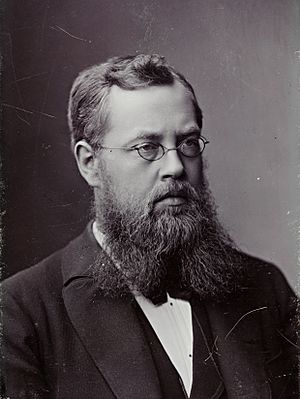Sophus Lie facts for kids
Quick facts for kids
Sophus Lie
|
|
|---|---|
 |
|
| Born | 17 December 1842 Nordfjordeid, Norway
|
| Died | 18 February 1899 (aged 56) Kristiania, Norway
|
| Nationality | Norwegian |
| Alma mater | University of Christiania |
| Known for | One-parameter group Differential invariant Contact transformation Infinitesimal transformation W-curve Carathéodory–Jacobi–Lie theorem Lie algebra Lie bracket Lie group Lie product formula Lie sphere geometry Lie theory Lie transform Lie's theorem Lie's third theorem Lie–Kolchin theorem See full list |
| Awards | Lobachevsky Medal (1897) ForMemRS (1895) |
| Scientific career | |
| Fields | Mathematics |
| Institutions | University of Christiania University of Leipzig |
| Doctoral advisor | Carl Anton Bjerknes Cato Maximilian Guldberg |
| Doctoral students | Hans Blichfeldt Lucjan Emil Böttcher Gerhard Kowalewski Kazimierz Żorawski Élie Cartan Elling Holst Edgar Odell Lovett |
Marius Sophus Lie (born December 17, 1842 – died February 18, 1899) was a famous Norwegian mathematician. He is best known for creating the idea of continuous symmetry. He used this idea to study geometry and differential equations.
Contents
Sophus Lie's Early Life and Education
Sophus Lie was born on December 17, 1842. He grew up in a small town called Nordfjordeid in Norway. He was the youngest of six children. His father was a pastor.
Sophus went to primary school in Moss. Then he attended high school in Oslo, which was called Christiania back then. After high school, he wanted to join the army. However, he was not accepted because of his poor eyesight. So, he decided to study at the University of Christiania.
Developing His Mathematical Ideas
Sophus Lie's first math paper was published in 1869. It was about geometry. That same year, he received a scholarship. He traveled to Berlin and met another mathematician, Felix Klein. They became good friends.
Later, Lie went to Paris. Klein joined him there. They also met other important mathematicians like Camille Jordan and Gaston Darboux. In 1870, the Franco-Prussian War started. Klein, who was from Prussia, had to leave France quickly. Lie went to Fontainebleau. He was arrested because people thought he might be a German spy. He became famous in Norway because of this. He was released after a month, thanks to Darboux's help.
In 1871, Lie earned his PhD from the University of Christiania. His thesis was about geometric transformations. Darboux called it "one of the most handsome discoveries of modern Geometry." The next year, the Norwegian Parliament created a special professor job just for him.
Working with Other Mathematicians
In 1872, Lie visited Klein again. Klein was working on a big math project at the University of Erlangen. For eight years, Lie also worked with Peter Ludwig Mejdell Sylow. They edited and published the math papers of another Norwegian mathematician, Niels Henrik Abel.
In 1874, Sophus Lie married Anna Birch. She was eighteen years old. They had three children: Marie, Dagny, and Herman.
From 1876, he helped edit a science journal. He worked with a doctor and a biologist on this journal.
In 1884, a mathematician named Friedrich Engel came to Christiania to help Lie. Engel helped Lie write his most important book series. It was called Theorie der Transformationsgruppen. This book was published in three parts between 1888 and 1893.
Later Life and Achievements
In 1886, Sophus Lie became a professor at the University of Leipzig. He took over from Felix Klein. In 1889, Lie became very ill and had to go to the hospital. He got better and returned to his job. However, his health got worse over the years.
In 1898, he resigned from his job and went back to Norway. He died the next year, in 1899, at age 56. He passed away from a serious illness called pernicious anemia.
Sophus Lie received many honors for his work. He became an Honorary Member of the London Mathematical Society in 1878. He also became a member of the French Academy of Sciences in 1892. In 1895, he became a Foreign Member of the Royal Society of London and the National Academy of Sciences of the United States of America.
Sophus Lie's Lasting Impact
Sophus Lie's most important discovery was about transformation groups. These are now called Lie groups, named after him. He found that these groups could be understood better by looking at their "infinitesimal generators." These generators form what is now called a Lie algebra.
Lie's work on group theory is still very important today. For example, Hermann Weyl used Lie's ideas in his work on quantum mechanics. Lie groups are now a key part of modern physics.
Sophus Lie also strongly supported creating a math prize. He wanted a prize like the Nobel Prize, but specifically for mathematics. This idea led to the creation of the Abel Prize. This award recognizes outstanding work in pure mathematics.
Lie taught many students who became successful mathematicians. Élie Cartan became one of the greatest mathematicians of the 20th century. Kazimierz Żorawski and Hans Frederick Blichfeldt also made important contributions to math.
Images for kids
See also
 In Spanish: Sophus Lie para niños
In Spanish: Sophus Lie para niños
- Lie derivative
- List of simple Lie groups
- List of things named after Sophus Lie




